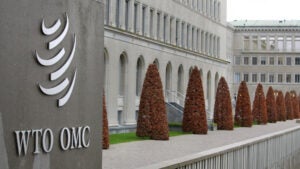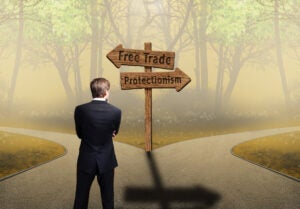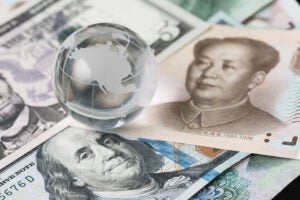The history of trade is fascinating. Its origins can be traced back to even before there was a human race (the forebears of our forebears relied on trade to supply them with obsidian for weapons and tools). Some scholars credit long-distance trade as a plausible reason for the invention of writing (to give instructions to distant agents). In ancient times, Athens sent its fleet to keep the grain it needed flowing through the Black Sea and shipped its highly sought-after sophisticated clay pottery to consumers on distant shores throughout the then-known world.
The modern era of trade can be traced to an important meeting between Winston Churchill and Franklin Roosevelt on a battle cruiser in Argentia Bay, Newfoundland, in August 1941, early in the Second World War. The two statesmen had been close observers of what had already been a catastrophic period comprised of unprecedented bloodletting in World War I followed by a global economic depression. They saw trade as a means to restore both peace and prosperity to the world. Theirs was a utopian vision – “to further the enjoyment by all states, great or small, victor or vanquished, of access, on equal terms, to the trade and to the raw materials of the world which are needed for their economic prosperity”. This policy, which they issued as a press statement, was of sufficient importance that it was forever known as the Atlantic Charter.
When the war was won, the vision was gradually made into reality. Twenty-three nations signed the first- ever multilateral trade agreement, the General Agreement on Tariffs and Trade (GATT), to be administered by an International Trade Organization (ITO). The ITO never came into being, but the parties to the GATT kept up their efforts, decade after decade, liberalizing trade under a system of agreed rules. There were eight great rounds of multilateral trade negotiations, each one becoming more complex, until the last, the Uruguay Round, which lasted eight years, from 1986 to 1994. The number of participants grew dramatically to 128 and they agreed to try again to create a World Trade Organization (WTO), this time successfully.
The world economy benefitted enormously. Trade flourished, economies grew, and peace reined among the major powers (until the Russian invasion of Ukraine). Before the multilateral trading system existed, real GDP took seven decades to quadruple, moving from US$1.92 trillion in 1870 to US$7.81 trillion in 1940. Over the next seven decades, world GDP grew by 14 times, from US$7.81 trillion in 1940 to USD 108.12 trillion in 2015. With the help of trade, hundreds of millions of people have been lifted out of poverty. Human life expectancy has increased over this period by 62 per cent due significantly to the organization of the world economy in favour of openness and living up to internationally agreed rules.
|
One of the defining transformations of the 20th century was globalization. Since the end of World War II, countries and cultures have become more interconnected than ever before, through free trade agreements, technology, multi-national corporations, and the creation of structures such as the IMF and the World Trade Organization. Trade economists liked to think that the benefits of globalization—economic growth, more consumer choice, lower prices—had made it unassailable. But cracks in the international order have started to appear.
In 2016, the surprise result of the Brexit referendum was seen as a repudiation by the U.K. general public of the decades-long European integration process. In 2018, the Trump administration, seizing on the loss of U.S. manufacturing jobs from offshoring and concerns about unfair industrial practices, instituted a range of tariffs on goods exported from China. President Biden has maintained the tariffs, even though they have led to higher prices and a decrease in the real income of American households. To this day, anti-globalization is a common theme in political campaign rhetoric. This rhetoric, while usually not supported by facts, has been incredibly persuasive, leading a large share of the American electorate to support measures that further limit free trade.
Davin Chor, an international trade economist at Tuck and a globalization chair at Dartmouth, was curious if evidence-based information derived from research, communicated in a concise way, could shift people’s preferences for trade protection. To answer this question, Chor and colleagues Laura Alfaro of Harvard Business School and Maggie Chen of George Washington University, conducted a series of survey experiments on a representative sample of the U.S. population from 2018 through 2022. As they explain in their new working paper—“Can Evidence-Based Information Shift Preferences Towards Trade Policy?”—what they found was both expected and surprising.
|
|
|
|
As the EU and the US hurry to agree on a way to collaborate on green steel before the end of October to prevent tariffs from snapping back into place, their diverging positions lay bare different philosophies on how global trade should be reorganised to account for climate priorities.
On 31 October 2021, the EU and the US temporarily resolved their Trump-era trade dispute over steel and aluminium tariffs by signing a joint statement on a “Global Arrangement on Sustainable Steel and Aluminium.”
This saw the removal of tariffs they levied against each other, agreeing to work together towards a decarbonised steel sector. Moreover, they decided to defend workers and fight global overcapacity, a key issue for the US that wanted to protect itself from subsidised Chinese steel.
The idea was that the agreement would be open to other countries who want to collaborate in less carbon-intensive steel and aluminium production, serving as a blueprint for making trade more environmentally friendly.
But the race is now to resolve key outstanding matters and conclude the agreement before US steel tariffs and the EU’s countervailing duties come back into force by 31 October.
Johanna Lehne, a trade and industrial decarbonisation expert at the climate change think tank E3G, who recently called for a reset of the negotiations, told EURACTIV, “Everything that we’ve heard suggests that they’re still quite far apart.”
A climate-friendly trade system?
The US government would like to form a “Green Steel Club” that protects itself with a common external tariff for steel and aluminium from third countries with more polluting steel industries or countries that subsidise their industry too excessively and thus create a global oversupply problem.
This would be convenient for the US as it could build on its current 232 tariffs, which it levies for national security reasons.
“What the Biden administration is trying to do is essentially convert that 232 system into a climate-friendly system,” Timothy Meyer, a professor in international law at Duke University with a specialisation in international trade, told EURACTIV.
The tariff level would be calculated by the “carbon intensity” of a third country’s steel and aluminium industry: The more polluting the steel sector in a given country, the higher the tariff.
Once there is a methodology to calculate carbon intensity, such an arrangement incentivises third-country governments to green their steel sectors.
|
|
|
|
Excerpts from In U.S.-China Trade War, Bystander Countries Increase Exports by Michael Totty.
The U.S.-China trade war began in mid-2018 when then-President Donald Trump hit China with a series of rising tariffs on a variety of imported goods and China retaliated by raising duties on U.S. products. (At the same time, the Trump administration also imposed duties on steel, aluminum and machinery imports from other trading partners.) The U.S. tariffs affected about $350 billion in imports from China, or about 18% of the total, while China’s tariffs covered about $100 billion, or about 11%, of goods imported from the U.S.
Although trade tensions eased in 2020 when the two countries agreed to put a freeze on plans for additional trade duties, the existing tariffs remain in place.
Tariffs Caused a Huge Shift in Trade
The tariffs quickly had an impact. An analysis by the Peterson Institute for International Economics found that in 2022, Chinese imports subject to the highest U.S. tariffs — including semiconductors, furniture and some consumer electronics — were about 25% below their levels before the start of the trade war. The decline wasn’t due to a larger economic slowdown — Chinese imports that weren’t covered by added duties, such as laptops and computer monitors, increased by 42%.
But what about the rest of the world? To see how the trade war affected exports from bystander countries, the authors examined data from the United Nations’ Comtrade database about the trading patterns of the 48 largest exporting countries, (excluding oil exporters) between 2014 and 2019.
They found that bystanders increased exports to the U.S. for products with high tariffs, but not to China. Shipments to the rest of the world increased for products subject to both U.S. and Chinese tariffs. Not only was there considerable variance among exporting countries, but also the most successful were those that were able to increase exports to the rest of the world, not just to the U.S.
Two factors seem to explain the difference. For one, successful exporters tended to ship goods that were substitutes for Chinese imports. So when U.S. customers looked for a replacement for, say, smartphones made in China, countries like Vietnam that made phones were poised to benefit.
What’s more, they were able to scale up production and achieve economies of scale so that the unit costs of their goods fell. This meant that the countries not only could compete successfully with the higher cost of taxed items, but their products became more competitive in markets that weren’t subject to the tariffs.
Vietnam, for instance, was one of the biggest winners from the trade war, increasing its exports of tires, sweatshirts and vacuum cleaners to both the U.S. and the rest of the world.
The study also suggests that successful countries weren’t just lucky enough to already specialize in products that would increase in demand after the trade-war tariffs hit. Instead, country-specific factors — such as a strong labor market or preexisting trade agreements — likely accounted for all the variation among countries.
|
|
|





